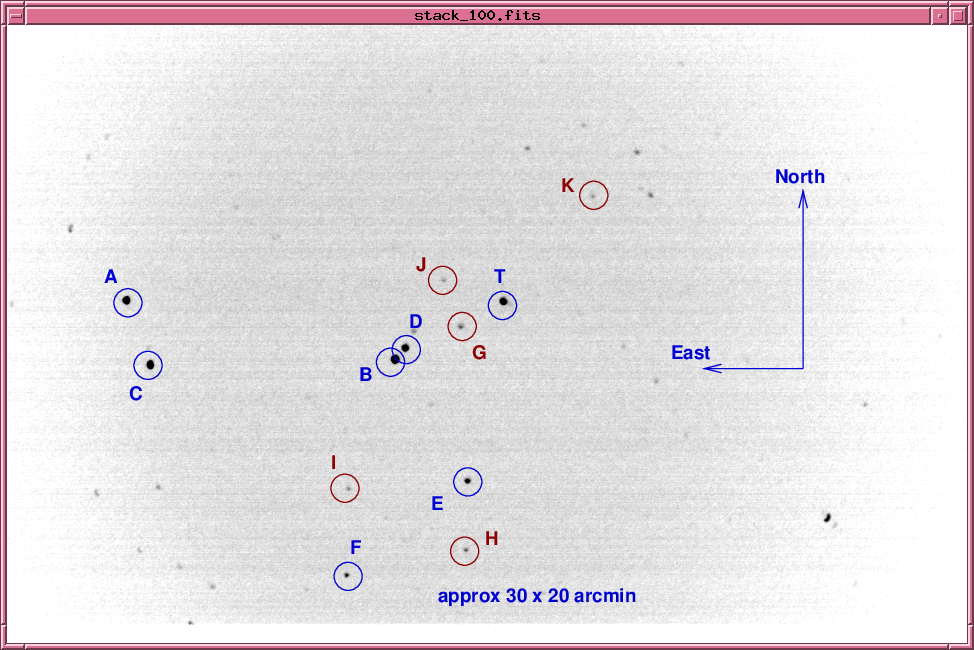
On the night of Sep 01/02, 2023, under good conditions, I just barely missed recording an occultation of TYC 1302-00855-1 by (776) Berbericia. All the equipment was set up and working properly, the telescope was sitting on the proper field and focused well, the camera was acquiring images with one minute to go. Unfortunately, for reasons I still don't understand, the telescope slowly slewed away from the field, and I wasn't able to re-acquire the target before the event finished. Sigh.
Still, it was a good test of the equipment and the procedures, so I'll show some properties of the pre-occultation measurements here.
The event was predicted by OccultWatcher program. For my location at the RIT Observatory, the program provided this information (just a bit on the right-hand edge of the graphic has been cut off -- whoops).

I used the high-speed occultation equipment kindly loaned to me by Lowell Observatory. You can find some descriptions of my earlier tests of it:
In short, the system is built around the FLIR Blackfly PGE-23S6M camera, which features the Sony IMX249 CMOS monochrome sensor. There is a small electronics box which reads GPS signals and triggers the camera to take pictures at precisely known starting times, so it's a very good tool for high-speed photometric measurements of occultations.
These observations involved:
Notes from the night:
The position of the target star, TYC 1302-00855-1, at V = 9.7, was
RA = 05:38:34.12 Dec = +17:47:18.5
The occulting asteroid, (776) Berbericia, was much fainter at about V = 12.7.
Here's a picture of the field, based on a single 40-msec image taken before the event. I've labelled the target as T and some other stars as well; their magnitudes are shown below the image.

The V-band magnitudes of these objects in the APASS9 catalog are shown below.
Star label APASS9 V-band mag
-------------------------------------------------------------------------
A 8.657
B 9.059
C 8.719
D 9.794
E 10.779
F 11.958
G 11.665
T 9.704 TYC 1302-00855-1 the occulted star
---------------------------------------------------------------------------
In order to see fainter objects, I aligned and median-stacked a set of 1000 consecutive frames. The objects labelled in red below aren't visible in individual frames, but only in the stacked version. The faintest labelled stars in this composite image are about V = 12.5.

There's enough of a background sky value in the stacked image to reveal that the optics don't fully illuminate the entire field (i.e., the system suffers from vignetting). The corners have very roughly 40%-50% of the light striking the center of the field. For occultation work, this won't matter in most cases; the areas outside the central region will only be used to help verify that the proper field has been acquired.
In order to check the photometric precision of the system -- which is a very important piece of information for planning occultation observations -- I performed aperture photometry with an aperture radius of 7 pixels (= 14 arcsec) and an outer sky annulus to the stars in each of 1000 consecutive frames. I then carried out inhomogeneous ensemble photometry on the set of 1000 frames and 9 stars, yielding a solution with the following properties.
The zeropoint of the ensemble varied slightly over the period of the 1000 frames (about 75 seconds) as shown in the graph below. Larger values mean "more clouds or other extinction". A variation by 0.6 mag means that the clouds moving past the field weren't so thin.

After correcting for these zero-point variations, we derive the following scatter around the mean value for each star. Recall that these are based on 40-millisecond exposures.

I'll be practicing over the next week in order to make another attempt on Sep 13, during the IOTA campaign to observe (704) Interamnia occulting TYC 2413-01489. I hope the weather cooperates.